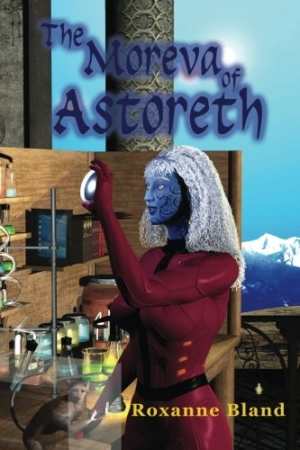The Moreva of Astoreth
Detailed world-building and a dynamic heroine make this fantasy novel stand out.
Roxanne Bland’s The Moreva of Astoreth adds elements of alien worlds, living gods, adventure, and a heroine with depth to deliver a thoroughly satisfying tale of crime and punishment on the galactic frontier.
Moreva Tehi is born into the one percent. She is descended from immortals, the Devi, and looks down on the hakoi, nondivine people she considers lesser beings. One problem: Tehi herself is part hakoi, a heritage she does her best to ignore. The contradiction, revealed early on, lays the groundwork for Tehi’s complex character. Though privileged and indulged, she is also passionately committed to finding a cure for the virulent red fever—so committed that she shirks her responsibilities as a priestess.
As punishment for her crime, Devi’s grandmother, the Goddess of Love, banishes her to a cold, remote, and backward post to take charge of a landing beacon. To add to her misery, Tehi finds she’ll be working closely with Laerd Teger, a hakoi and village headman.
Like Tehi herself, the world of the book is complex. While science and technology are advanced, society is ancient. Gods have temples, there is no separation of church and state, and the Devi rule. Yet despite the rigid hierarchy, Tehi’s grandmother also teaches tolerance and compassion, and part of the reason Tehi is sent to Syren is to overcome her prejudices toward the hakoi.
The beacon, the village, and the remote territory of Syren are as foreign to Tehi as they are to readers, and introducing them through her eyes is an economical choice. An initial tour of the village is especially well-imagined and colorful.
In Syren, Tehi inhabits a castle-like complex that towers above the village. The repeated actions of stepping in and out of gliding elevators going up and down stairways, and finding shortcut passages sometimes slows the pace, but the creation of a world resembling a three-dimensional maze adds heft to the story.
Thrown into close contact with Laerd Teger, Tehi at first clings to her disdain for all things hakoi. However, when she learns that Laerd Teger has lost his wife and child to red fever, the ice begins to melt. When he protects her from hakoi villagers who dislike her as much as she dislikes them, and Tehi feels the sting of prejudice for herself, more barriers come down. The slow evolution of their relationship is refreshing, and is an effective counterpoint to the swift pace of action as Tehi steps up her efforts to find a cure for red fever.
Writing is solid throughout, and the voice of the book—both in Tehi’s words and in dialogue among the characters—manages to sound spontaneous and contemporary without being out of step with the setting.
The arresting cover makes use of explosive color and enticingly represents the content by combining hints of ancient Egypt with attention to detail and an imaginative, digital design.
Detailed world-building, a dynamic heroine, and the echo of contemporary issues like prejudice, biracial identity, and crossing cultural lines to be with someone you love make The Moreva of Astoreth a standout.
Reviewed by
Susan Waggoner
Disclosure: This article is not an endorsement, but a review. The publisher of this book provided free copies of the book and paid a small fee to have their book reviewed by a professional reviewer. Foreword Reviews and Clarion Reviews make no guarantee that the publisher will receive a positive review. Foreword Magazine, Inc. is disclosing this in accordance with the Federal Trade Commission’s 16 CFR, Part 255.

